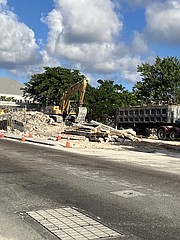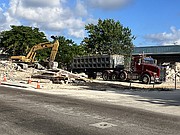THERE’S a once-in-a-century opportunity in the life of a city to reshape Downtown Nassau and it’s staring us right in the face, begging, pleading for every great idea we’ve got.
After decades of talk, cajoling, pleading, reasoning, after tens of thousands of dollars’ worth of studies, after moving container shipping out of town and letting some of it slip back in, after calls for creation of a Business Improvement District (BID) and promises that the real estate known as East of East Street would finally one day be desirable, it’s on the verge of happening.
The Ministry of Tourism, Investments and Aviation made a promise to rejuvenate Downtown Nassau and By George, they are keeping it.
First, two eyesores came down on Cumberland Street. Could they have been repurposed and renovated? Probably so. But no one was doing it and at least one of the buildings was literally dropping apart with heavy chunks of concrete hitting the ground where pedestrians walk in a busy section of town.
But now in rapid-fire fashion, buildings east of East Street are being demolished at a pace that feels almost frantic, though I prefer to think of it as determined. To understand how they got to this state where a pile of rubble is a better option than what stood there before, you have to appreciate the downward trajectory of east of East Street.
Once a bustling commercially viable economic centre, what it lacked in architectural wonderment was compensated by the purpose it served – the marine-based hub where Nassau Shipyard hauled the largest of seagoing vessels during World War II and well into the 80s until it closed, where cargo for the capital and most Family Islands landed and was trucked or loaded on mailboats.
It was a hustle-bustle harbour economy before the words blue economy were ever fashionable. But it was also adjacent to the main tourism and financial centre, geographically a block away, and as whatever lay west of East Street blossomed into a luxury shopping mecca and a global financial services centre, east became the stepchild.
Over time, with the shipyard closed and the building at 601 E Bay vacated and sometimes leased, with cargo shipping moved to make way for what was expected to be a surge of interest in this prime waterfront real estate that would transform downtown into an urban oasis, the reality was that nothing much good happened.
Construction equipment began to fill abandoned lots, new heavy equipment blocking the view like the stacks of cargo containers did before.
Plans for high rises were submitted and rejected. Administrations came and went and the stepchild of historic Nassau remained an outside child.
Landowners who would have had hefty property tax bills if they had fixed up their property made the predictable and reasonable financial decision to sit on it. If they could not turn the land they owned into a development that would earn revenue, why bother doing anything? They could sit on it as long as they wanted. Land wasn’t going anywhere. Unfortunately, neither was east of East Street despite occasional small attempts and Charles Klonaris’s major multi-million investment in storefronts, office and restaurant spaces along with marina slips at Elizabeth on Bay.
Where owners failed to act, bulldozers plowed through, mowing down decades of neglect in less time than it takes to do a school pickup and get back to work. The old Corona Hotel, closed for as long as I can remember, smashed to smithereens. Old office buildings, former shops, places where a shingle once promised that inside was a lawyer who could write your will or a dress that would be perfect for church on Sunday was waiting on the rack – now piles of concrete removed and history wiped clean in a day.
Fortunately, those in charge, including Sen. Randy Rolle who has spearheaded this mission with absolute resolve to get things done, did involve the Antiquities, Monuments and Museums Corporation to identify buildings of historic, cultural or architectural merit that deserved to be preserved.
Now the critical question arises.
With vacant pockets of prime real estate, how do we move this stepchild of historic Nassau from the back door into the place it has been knocking on the door of for nearly half a century?
We create a dual driver based on a residential component and an experiential economy – experiences that can be enjoyed by locals interacting with the millions of visitors who are deposited by cruise ships to Nassau’s front door. This is the moment when we look at east of East Street as the new future of historic Nassau with art studios, music workshops, demonstrations of Junkanoo costume creation and varieties of straw plaiting, storytelling, a place to tell our story starting with Lucayan Indians and a place that comes alive at night with outdoor cafes, wine bars, an artist on the street doing chalk portraits. We need a large cooling centre with fountains, a green market, a grassy knoll where vendors can set up a table for a day, a monthly invitation for puppies on leashes to strut their stuff.
There will be design charrettes and all voices should be heard, architects and planners and engineers and stakeholders, but the bottom line is that relying on ultra luxury shopping is unrealistic. Those days are over. What today’s traveller wants is experiences. This is not 5th Avenue in New York or Rodeo Drive in Beverly Hills. Sure, there will always be the shopper who wants a Rolex or a Cartier, but for the most part, this is a middle market city that does not understand the potential at its fingertips.
Now we have the opportunity to get it right – Downtown Nassau, a fashionable place to live, a desirable place to dine, an enviable space to just chill or talk with an artist, listen to a musician, find a new way to satisfy our desire for more experiences and our guests’ desire for more Nassau. The harbourfront, where it all began more than 300 years ago, and where it is being reborn today. We can get it right if we think beyond more of what exists and focus on what could be.







Comments
Dawes 7 months, 1 week ago
Why anyone would want to live or have an office downtown is beyond me. A couple of times each month Bay street is closed making it a hassle to get to. Much better to live outside the town and be able to get to work or your home in an easy fashion.
Flyingfish 7 months, 1 week ago
This way of thinking is precisely why Bay St. became an empty husk in the first place. Bay St(downtown Nassau) was historically a very residential with many shop owners living above their keep or a couple of blocks away.
The city was designed for horses, bikes, and residential traffic. When the residents who once lived in the downtown area moved out (west or east), the businesses that served these residents also moved as well.
We were able to replace some of these stores with tourist shops and financial, and Maritime offices but it's clear today we don't have the demand for Nassau to be an office-only city. Moreover, the city was designed to be lived and that is the only way to get enough demand for business.
Sign in to comment
Or login with:
OpenID